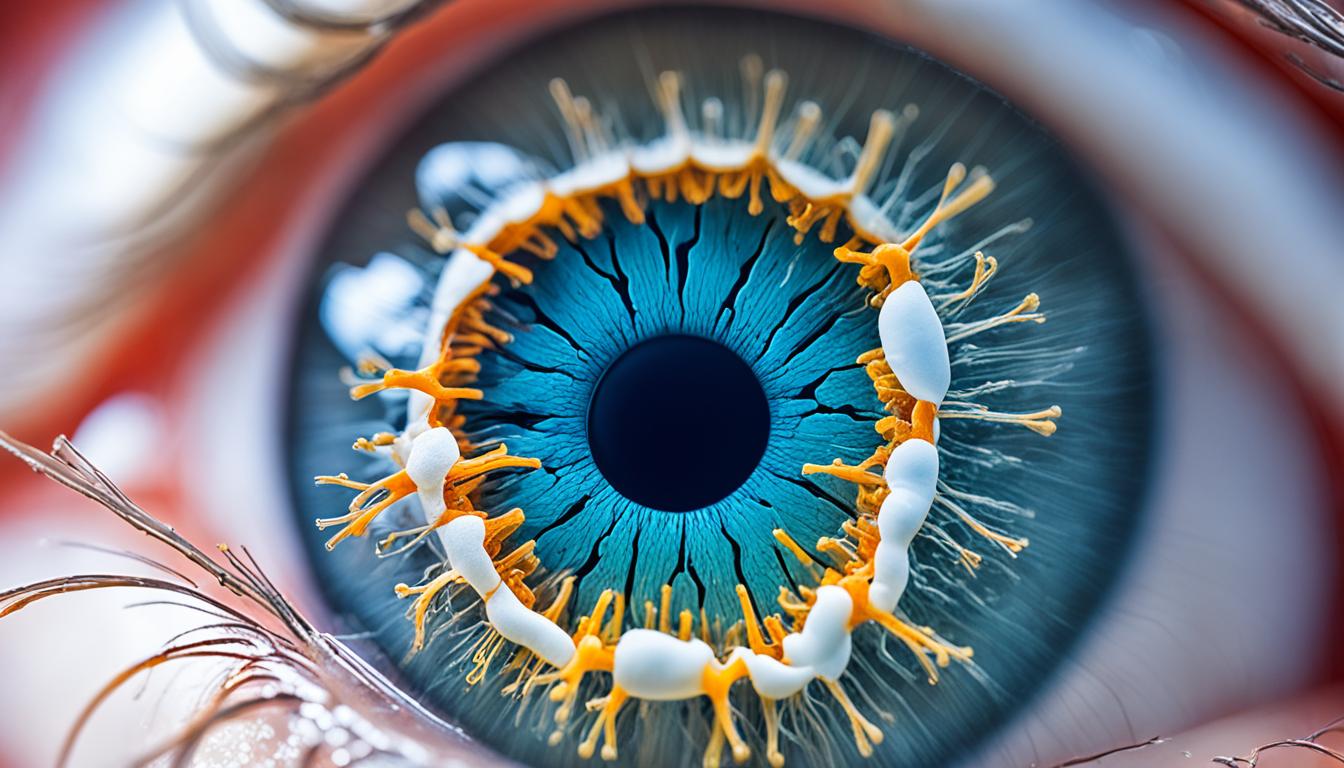Floaters are common vision problems. Many people see small specks or lines that move in their vision. These are caused by tiny bits in the vitreous gel of the eye. Although most are harmless, they can be annoying and limit what someone sees.
Floaters come in many shapes, like dots, lines, clouds, or veils. They can be seen in one or both eyes. These shapes might slightly affect vision or cause serious issues. Floaters can come from getting older, eye injuries, or health problems like eye inflammation.
If you suddenly see more floaters or have eye pain, see a doctor. Tests can be done during an eye exam to check the problem.
How floaters are treated depends on how bad they are. You might just need dark glasses. Sometimes, surgery is needed like a vitrectomy or laser therapy.
Stem cell treatment could be a future way to handle floaters. Scientists are still learning about how it could help.
Key Takeaways:
- Floaters are small specks or lines that float in a person’s field of vision.
- Causes of floaters can include age-related changes in the vitreous gel, injury to the eye, or underlying medical conditions.
- Seek medical attention if there is a sudden increase in floaters or if they are accompanied by other symptoms such as blurred vision or eye pain.
- Floaters can be diagnosed through a comprehensive eye examination.
- Treatment options for floaters range from conservative approaches to more invasive procedures.
- Stem cell therapy is being explored as a potential treatment option for floaters, but more research is needed.
Causes and Types of Floaters
Floaters can come from many causes and have different types. The most common are from getting older. As you age, changes in the eye’s vitreous gel can cause these floaters. This gel turns more liquid and forms clumps or fibers. They then cast shadows on our retina, showing up as floaters.
If you see a lot of floaters all of a sudden, it could be serious. This might mean you have eye problems like retinal tears, detachment, bleeding, or diseases. Getting these checked right away can help prevent more eyesight issues. Remember, most floaters don’t need immediate attention. But sudden changes mean you should see an eye doctor.
Floaters and their Causes
Floaters, or vitreous floaters, are common as we get older. The vitreous gel in the eye can build up clumps or fibers, especially with age. These can shadow the retina, causing floaters.
Sometimes floaters can signal a big problem. If you have floaters because of eye injuries, myopia, or surgeries, it might be fine. But some health issues, like eye bleeding, can be serious. Seeing a doctor early can help protect your eyesight.
Other Causes of Floaters
Floaters might also come from injuries or eye traumas. People with myopia might see more floaters. Some surgeries or medicines can also make floaters appear.
When to Seek Medical Attention
Most of the time, floaters are no big deal. But if you notice a lot of new floaters or a change, it’s smart to get checked. A doctor can tell you if there’s a serious problem behind them.
Diagnosis and Treatment of Floaters
To diagnose floaters, a full eye exam is needed. This exam often includes a dilated one to check the retina and eye structures. This is how eye doctors spot floaters and possible risks to your eyesight.
The way floaters are treated depends on how bad they are and why they appear. If they’re not too bothersome, you might not need treatment. Sometimes, they get better on their own. Wearing sunglasses might also help make them less of a bother.
If floaters are really bothering you, surgery could be an option. Vitrectomy is one type. It removes the vitreous gel from your eye, replacing it with a clear liquid. This surgery can get rid of floaters but can lead to other problems, like cataracts.
Laser therapy is a different approach, using a special laser (Nd: YAG). It breaks up the floaters’ particles, making them less noticeable or getting rid of them. Yet, it’s not for everyone, and it has its own risks, like cataracts or hurting the retina.
The right treatment choice depends on what’s best for you, decided with your eye doctor’s advice.
| Treatment Option | Description |
|---|---|
| Vitrectomy | A surgical procedure to remove the vitreous gel and replace it with a clear solution, eliminating floaters. |
| Laser Therapy (Nd: YAG laser vitreolysis) | Uses laser energy to break up floater particles, reducing their visibility or eliminating them. |
Stem Cell Therapy for Floaters: An Emerging Treatment Option
Stem cell therapy is a groundbreaking method in regenerative medicine. It targets floaters, aiming to use stem cells to fix issues in the eye. This treatment fixes the vitreous gel using the unique abilities of stem cells.
This method could reduce eye floaters’ effects and stop more eye problems from happening. Although it’s new, there are many studies to make sure it’s safe and works well. Yet, it’s not easily available everywhere.
If you’re thinking about this therapy, talking to an eye specialist or a researcher is a good idea. They can explain what’s going on in research and if you can join any trials. Working together, doctors and researchers hope to change how eye problems like floaters are handled in the future.

